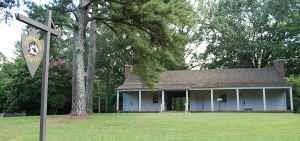Parkway Information Cabin Natchez Trace Parkway
Introduction
Text-to-speech Audio
Formerly home to the Mississippi Crafts Center, this cabin now serves as one of four visitors centers staffed by National Park Service employees along the Natchez Trace Parkway. The second-longest parkway in the United States, the Natchez Trace Parkway is a recreational road that follows a historic route used by Native Americans and early settlers. The Parkway begins near Nashville, Tennessee and ends in Natchez, Mississippi, passing through Alabama along the way. A trail-head for the paved Ridgeland Multi-Use Path can be found behind the Visitors Center. The visitors center also offers maps along with a few small exhibits and information about explorers, settlers, and the Choctaw and other tribes that used the Natchez Trace.
Images
This cabin is one of four staffed visitors centers along the Natchez Trace Parkway.

Backstory and Context
Text-to-speech Audio
The Natchez Trace Parkway follows the route of the Old Natchez Trace from Natchez, Mississippi to Nashville, Tennessee. It was started in 1938 and finished in 1993 with the completion and the 1994 opening of the Double Arch Bridge in Tennessee. The parkway has become a mecca for tourists everywhere. There are many places to visit along the parkway and many opportunities to enjoy the scenery. Bicyclists, motorcyclists, and motorists also enjoy using the route, which is friendly to all who use it. There is a speed limit of 50-miles-per-hour throughout all but one stretch of parkway, where the speed limit is lowered to 40 mph. And there are several places where one can get off the parkway and travel on the Old Natchez Trace. On and off the parkway, one can travel the route traversed by people such as Meriwether Lewis and General and President Andrew Jackson.
The Old Natchez Trace was first used by foraging bison, and then Native Americans. Later travelers included European settlers, Kaintucks (who were mostly from Kentucky), slave traders, explorers, and soldiers. Many trading posts were active along the way. There are so many places to eat, shop, and visit. Many of them are listed on the Clio. The Natchez Trace was a major trade route until the coming of the steamboat and the ability to transport goods and services along the Mississippi River became much easier. But locals continued to use it, and it was later declared a national park. The Old Natchez Trace reached its peak of usage between 1785 to 1820.
The Old Trace went through Choctaw and Chickasaw lands. There are also mounds that were created by Native Americans over the course of more than 2,000 years, especially in Mississippi. One of these is Emerald Mound, the largest along the Natchez Trace Parkway. Covering eight acres and 70-feet-tall at its highest point, it was occupied until 1600.;
Sources
1. 1993 Natchez Trace Parkway arches are complete. History.com. Accessed August 04, 2018. https://www.history.com/this-day-in-history/natchez-trace-parkway-arches-are-complete.
2. Elliott Jr, J. (2017). Paving the Trace. Mississippi History Now. Accessed August 04, 2018. http://mshistorynow.mdah.state.ms.us/articles/311/paving-the-trace.
3. Explore Parks Natchez Trace Parkway. National Park Foundation. Accessed August 04, 2018. https://www.nationalparks.org/explore-parks/natchez-trace-parkway.
4. Hughes D. - Explore Tennessee. Exploring the Natchez Trace Parkwway. The Tennessean. Accessed July 12, 2018. https://www.tennessean.com/story/exploretennessee/2018/05/22/exploring-natchez-trace-parkway/6194560....
6. Natchez Trace. National Park Service. Accessed August 04, 2018. https://www.nps.gov/natr/index.htm.
7. Natchez Trace - Mounds. National Park Service. Accessed August 04, 2018. https://www.nps.gov/natr/mounds.htm.
8. Natchez Trace – Traveled for thousands of years. (2018). Legends of America.com. Accessed August 04, 2018. https://www.legendsofamerica.com/ms-natcheztrace/.
